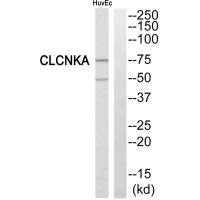CLCNKA Antibody
-
货号:CSB-PA831274
-
规格:¥2024
-
图片:
-
其他:
产品详情
-
产品名称:Rabbit anti-Homo sapiens (Human) CLCNKA Polyclonal antibody
-
Uniprot No.:P51800
-
基因名:CLCNKA
-
宿主:Rabbit
-
反应种属:Human
-
免疫原:Synthesized peptide derived from C-terminal of Human CLCNKA.
-
免疫原种属:Homo sapiens (Human)
-
克隆类型:Polyclonal
-
纯化方式:The antibody was affinity-purified from rabbit antiserum by affinity-chromatography using epitope-specific immunogen.
-
浓度:It differs from different batches. Please contact us to confirm it.
-
产品提供形式:Liquid
-
应用范围:ELISA,WB
-
推荐稀释比:
Application Recommended Dilution WB 1:500-1:3000 -
Protocols:
-
储存条件:Upon receipt, store at -20°C or -80°C. Avoid repeated freeze.
-
货期:Basically, we can dispatch the products out in 1-3 working days after receiving your orders. Delivery time maybe differs from different purchasing way or location, please kindly consult your local distributors for specific delivery time.
相关产品
靶点详情
-
功能:Voltage-gated chloride channel. Chloride channels have several functions including the regulation of cell volume; membrane potential stabilization, signal transduction and transepithelial transport. May be important in urinary concentrating mechanisms.
-
基因功能参考文献:
- Single loci of tag Single Nucleotide Polymorphisms of CLCNKA_B are not enough to increase the Essential Hypertension susceptibility, the combination of CLCNKA SNP, salt, marine products, meat, edible oil consumption is associated with elevated risk. PMID: 25919862
- R8W and G47R, two naturally occurring barttin mutations identified in patients with Bartter syndrome type IV, reduce barttin palmitoylation and CLC-K/barttin channel activity. PMID: 26013830
- HEK293 cells the potentiating effect of niflumic acid (NFA) on CLC-Ka/barttin and CLC-Kb/barttin channels seems to be absent while the blocking efficacy of niflumic acid and benzofuran derivatives observed in oocytes is preserved PMID: 24863058
- following variables were significantly associated with an estimated glomerular filtration rate: age, type 2 diabetes, total cholesterol, LDL-cholesterol, and the CLCNKA GG genotype PMID: 23850580
- The variant CLCNKA risk allele, telegraphed by linked variants in the adjacent HSPB7 gene, uncovers a previously overlooked genetic mechanism affecting the cardio-renal axis. PMID: 21248228
- Identify a protein region that is involved in calcium binding and that is likely undergoing conformational changes underlying the complex gating of CLC-K channels. PMID: 20805576
- Combined impairment of ClC-Ka and ClC-Kb results in phenotype that mimics neonatal Barrter's syndrome with deafness PMID: 15044642
- Barttin modulates trafficking and function of ClC-K1 and ClC-Kb channels PMID: 16849430
- CLCNKA genetic variants may have roles in salt-sensitive hypertension PMID: 17510212
- The structure of the cytoplasmic domain of CLCNKA reveals a conserved interaction interface. PMID: 17562318
- Disruption of the gene encoding Barttin, BSND, results in a 'double knockout' of the functions of both ClCKA and ClCKB, manifesting as Bartter syndrome type IV with sensorineural deafness and an especially severe salt-losing phenotype. PMID: 18094726
- ClC-Ka and ClC-Kb differ in how conformational changes are translated to the extracellular domain, despite the fact that the cytoplasmic domains share the same quaternary structure PMID: 18648499
显示更多
收起更多
-
相关疾病:Bartter syndrome 4B, neonatal, with sensorineural deafness (BARTS4B)
-
亚细胞定位:Membrane; Multi-pass membrane protein.
-
蛋白家族:Chloride channel (TC 2.A.49) family, CLCNKA subfamily
-
组织特异性:Expressed predominantly in the kidney. All nephron segments expressing BSND also express CLCNK proteins.
-
数据库链接:
HGNC: 2026
OMIM: 602024
KEGG: hsa:1187
STRING: 9606.ENSP00000332771
UniGene: Hs.591533
Most popular with customers
-
-
YWHAB Recombinant Monoclonal Antibody
Applications: ELISA, WB, IF, FC
Species Reactivity: Human, Mouse, Rat
-
Phospho-YAP1 (S127) Recombinant Monoclonal Antibody
Applications: ELISA, WB, IHC
Species Reactivity: Human
-
-
-
-
-





















